You’ve been dreaming about your very own tiny house for years. Are you ready to take the leap?
Here are all the steps you’ll take in the tiny house buying process.
Choose a tiny house site.
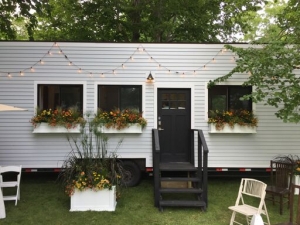 For some this is easy: a backyard, a piece of property in a town that allows RVs, or an RV park. For those who don’t yet know where to put their tiny house, finding a location to put their tiny house is a crucial step. We’ll build your tiny house differently depending on whether you plan to travel often with your house or it’ll stay in one place. There are many different customization options available for your tiny house, which often depend on what kind of utilities are available at your tiny house site.
For some this is easy: a backyard, a piece of property in a town that allows RVs, or an RV park. For those who don’t yet know where to put their tiny house, finding a location to put their tiny house is a crucial step. We’ll build your tiny house differently depending on whether you plan to travel often with your house or it’ll stay in one place. There are many different customization options available for your tiny house, which often depend on what kind of utilities are available at your tiny house site.
You’ll need to make sure your site has an access road and enough room for a truck to deliver the tiny house. If you send us the layout of your property we’ll help you determine the best spot to place your tiny house during your design session.
Here’s a blog post on where to put your tiny house, and what to know if you’re thinking of buying land for your tiny house.
One way to find a location is through networking. Here’s a list of tiny house networking sites: most of these groups are through Facebook or Meetup.
If you’re finding it difficult to find a town that already allows tiny houses, you’re not alone. In fact, most towns’ Planning/Zoning Boards haven’t even considered whether to allow tiny houses on wheels: all it’ll take to start the wheels turning (pun intended, sorry) is for someone to ask. The American Tiny House Association (Website, Facebook) is a great resource for those who would like to ask for permission to live in their tiny houses.
Choose a tiny house model.
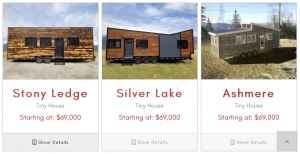 Know where you’ll put your tiny house? Great! Browse our tiny house catalogue online and decide which model is the best for you. Each of our models is customizable: customizations like materials and paint colors are free, while having our designer change the blueprints is an extra fee.
Know where you’ll put your tiny house? Great! Browse our tiny house catalogue online and decide which model is the best for you. Each of our models is customizable: customizations like materials and paint colors are free, while having our designer change the blueprints is an extra fee.
Some of our tiny houses are the road-legal limit of 8 1/2′ wide. If you’re looking for a tiny house you can tow with you, check out our Lightweight Models for Towing. We also offer Park Model Tiny Houses at 10′ wide, the Taconic and the Kinderhook. Park Models are great when you want a little extra elbow room and don’t plan to move your tiny house after it’s put in place.
Don’t want to climb up a ladder to go to bed? Click here to see our models with a first-floor bed.
Get your finances ready.
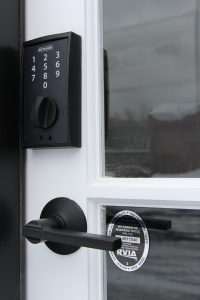 B&B’s Tiny Houses on wheels are inspected by the Recreation Vehicle Industry Association, or the RVIA. Your tiny house will come with an individual seal showing it’s been certified. Because they’re certified to RVIA standards, our tiny houses are legally considered RVs, and can get RV financing, insurance, and access to RV parks. Having this certification also helps when explaining to your town’s Planning and Zoning Board exactly what a tiny house is and how it’s certified.
B&B’s Tiny Houses on wheels are inspected by the Recreation Vehicle Industry Association, or the RVIA. Your tiny house will come with an individual seal showing it’s been certified. Because they’re certified to RVIA standards, our tiny houses are legally considered RVs, and can get RV financing, insurance, and access to RV parks. Having this certification also helps when explaining to your town’s Planning and Zoning Board exactly what a tiny house is and how it’s certified.
If you’ll use financing, down payments differ based on the financial institution, but they’re generally between 20 and 25%. If you’ll pay cash, we generally charge 60% up front and 40% when the house is complete. You’ll need to have this amount saved before you buy a tiny house.
To find out about how much the tiny house you want would cost, try our Instant Estimate Generator. This will give you a ballpark estimate so you’ll know how much to save. If you’re not comfortable with your first estimate, you can go back through the Estimator as many times as you’d like, choosing different options. Here are some suggested financial institutions for getting RV financing for your tiny house.
Keep in mind that the cost of the tiny house itself isn’t the only expense you may have when placing a tiny house. Depending on your site and what your municipality requires, you may need to have utilities connected, a gravel or concrete pad poured, and anchors installed. If you’re not towing your tiny house yourself, you’ll need to pay about $2 per mile for delivery (we’ll connect you with our trusted delivery company). It’s important to factor in the all-in cost of buying a tiny house before paying a deposit.
Schedule a tiny house design session.
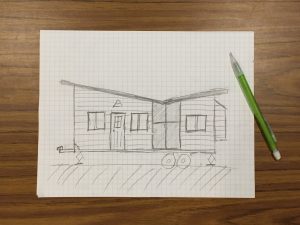 Whether you’d like to make changes to the blueprints of the tiny house or not, a design session is the next step. If the only design changes are your selections for colors, materials and fixtures, these choices are free to make; the cost of the materials you choose will be reflected in your final quote. If you’ll make changes to the blueprints, we charge a Design Alteration fee before our design session (scroll down past the customization options to see the fee).
Whether you’d like to make changes to the blueprints of the tiny house or not, a design session is the next step. If the only design changes are your selections for colors, materials and fixtures, these choices are free to make; the cost of the materials you choose will be reflected in your final quote. If you’ll make changes to the blueprints, we charge a Design Alteration fee before our design session (scroll down past the customization options to see the fee).
Contact us to set up a time for a design session, whether via Skype, phone, or in-person. If your session is in person, we’ll walk you through any tiny house that we may have at our shop so you can get a feel for the space. During our design session, we’ll go through, in detail, which options you’d like, and the pros and cons of each depending on your location and how you’ll be using your tiny house. You’ll have a chance to get your tiny house questions answered as well as learn more about which options are realistic for your living situation.
We’ll create a quote for you and send you a contract.
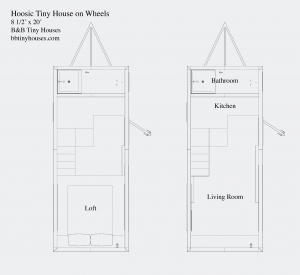 After your design session, our team will create a quote for your tiny house. If you need changes to the existing plans, we’ll create a new drawing: this can take a few weeks depending on our design pipeline.
After your design session, our team will create a quote for your tiny house. If you need changes to the existing plans, we’ll create a new drawing: this can take a few weeks depending on our design pipeline.
We’ll review your quote and final customization plan (your choices for colors, materials, fixtures, etc.) with you.
When you’re ready to finalize your choices and move forward, we’ll send you a build contract.
When we receive your signed contract and first payment (if you’re paying with cash, 60%; if you’re financing, we’ll need the payment from your financial institution) we’ll start ordering materials for your tiny house.
We’ll build your tiny house.
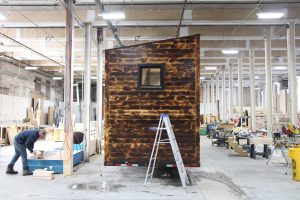 Our build schedule varies throughout the year: sometimes we can start building a tiny house right away, and other times there will be other projects in the pipeline. We’ll be sure to keep you updated on our build schedule.
Our build schedule varies throughout the year: sometimes we can start building a tiny house right away, and other times there will be other projects in the pipeline. We’ll be sure to keep you updated on our build schedule.
Trailers take about five weeks to build; your tiny house, depending on its size and level of complexity, should take 6-12 weeks after that depending on our build schedule. We’ll keep in touch with you during the build process.
Get your site ready.
 The needs of tiny house sites vary greatly. If you’ll be traveling with your tiny house and parking it at RV Parks, there’s not much you’ll need to do other than reserve your spot. If you’ll be keeping your tiny house in one place, you’ll need to make sure you can get water and power to your tiny house and waste water away from it. Depending on the permanency of your tiny house, you may want to have a gravel or concrete pad poured, and lay water and electric lines. If you’re going solar, you’ll need to contract with a solar company to have your panels installed on your site.
The needs of tiny house sites vary greatly. If you’ll be traveling with your tiny house and parking it at RV Parks, there’s not much you’ll need to do other than reserve your spot. If you’ll be keeping your tiny house in one place, you’ll need to make sure you can get water and power to your tiny house and waste water away from it. Depending on the permanency of your tiny house, you may want to have a gravel or concrete pad poured, and lay water and electric lines. If you’re going solar, you’ll need to contract with a solar company to have your panels installed on your site.
Pick up your tiny house at our shop or have it delivered to your site.
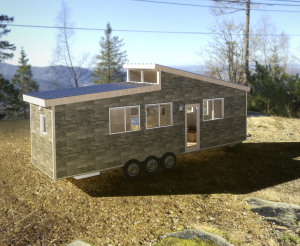 If you’ll be towing your tiny house, here’s a primer on what size vehicle you’ll need.
If you’ll be towing your tiny house, here’s a primer on what size vehicle you’ll need.
Those who do not plan to tow their own tiny house may have it professionally delivered to their site. Contact us for a delivery estimate. We’ll schedule a time with you to ensure you’re on-site when your house is delivered, and we’ll answer any questions you might have about setting it in place.
Ready to choose a tiny house model? Check out our Tiny House Designs and then get an Instant Estimate.
Have Questions? Contact us.

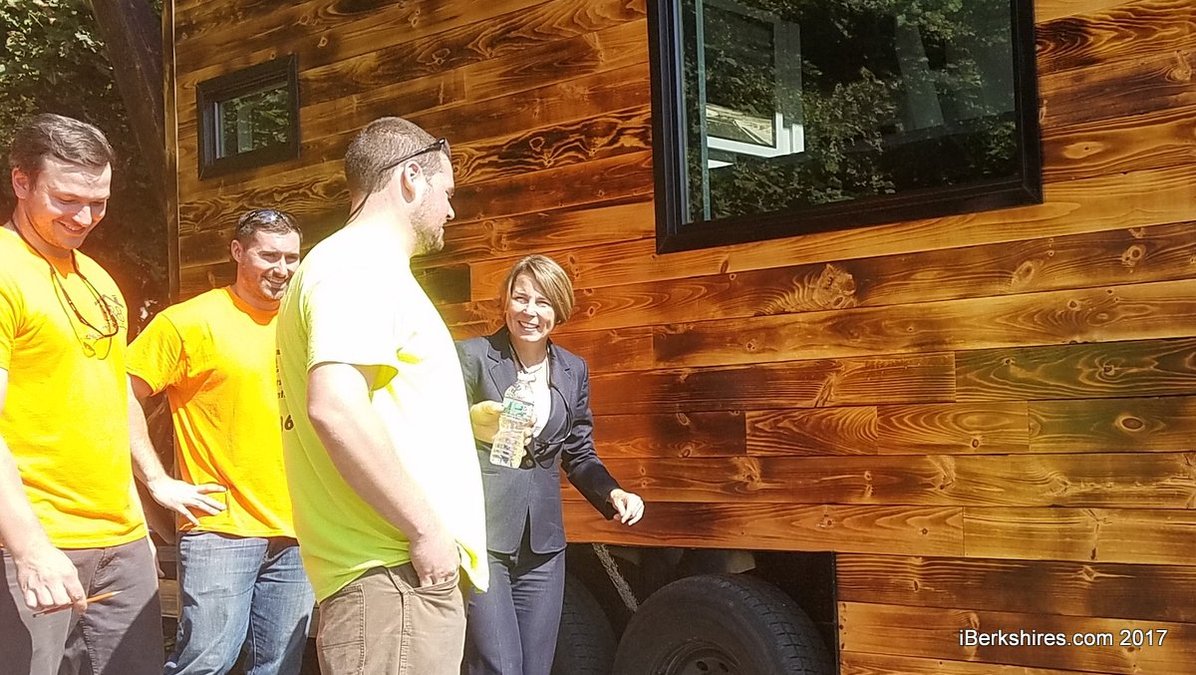
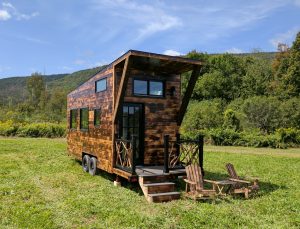
 For some this is easy: a backyard, a piece of property in a town that allows RVs, or an RV park. For those who don’t yet know where to put their tiny house, finding a location to put their tiny house is a crucial step. We’ll build your tiny house differently depending on whether you plan to travel often with your house or it’ll stay in one place. There are many different customization options available for your tiny house, which often depend on what kind of utilities are available at your tiny house site.
For some this is easy: a backyard, a piece of property in a town that allows RVs, or an RV park. For those who don’t yet know where to put their tiny house, finding a location to put their tiny house is a crucial step. We’ll build your tiny house differently depending on whether you plan to travel often with your house or it’ll stay in one place. There are many different customization options available for your tiny house, which often depend on what kind of utilities are available at your tiny house site.
 B&B’s Tiny Houses on wheels are inspected by the Recreation Vehicle Industry Association, or the RVIA. Your tiny house will come with an individual seal showing it’s been certified. Because they’re certified to RVIA standards, our tiny houses are legally considered RVs, and can get RV financing, insurance, and access to RV parks. Having this certification also helps when explaining to your town’s Planning and Zoning Board exactly what a tiny house is and how it’s certified.
B&B’s Tiny Houses on wheels are inspected by the Recreation Vehicle Industry Association, or the RVIA. Your tiny house will come with an individual seal showing it’s been certified. Because they’re certified to RVIA standards, our tiny houses are legally considered RVs, and can get RV financing, insurance, and access to RV parks. Having this certification also helps when explaining to your town’s Planning and Zoning Board exactly what a tiny house is and how it’s certified. Whether you’d like to make changes to the blueprints of the tiny house or not, a
Whether you’d like to make changes to the blueprints of the tiny house or not, a  After your design session, our team will create a quote for your tiny house. If you need changes to the existing plans, we’ll create a new drawing: this can take a few weeks depending on our design pipeline.
After your design session, our team will create a quote for your tiny house. If you need changes to the existing plans, we’ll create a new drawing: this can take a few weeks depending on our design pipeline. Our build schedule varies throughout the year: sometimes we can start building a tiny house right away, and other times there will be other projects in the pipeline. We’ll be sure to keep you updated on our build schedule.
Our build schedule varies throughout the year: sometimes we can start building a tiny house right away, and other times there will be other projects in the pipeline. We’ll be sure to keep you updated on our build schedule. The needs of tiny house sites vary greatly. If you’ll be traveling with your tiny house and parking it at RV Parks, there’s not much you’ll need to do other than reserve your spot. If you’ll be keeping your tiny house in one place, you’ll need to make sure you can get water and power to your tiny house and waste water away from it. Depending on the permanency of your tiny house, you may want to have a gravel or concrete pad poured, and lay water and electric lines. If you’re
The needs of tiny house sites vary greatly. If you’ll be traveling with your tiny house and parking it at RV Parks, there’s not much you’ll need to do other than reserve your spot. If you’ll be keeping your tiny house in one place, you’ll need to make sure you can get water and power to your tiny house and waste water away from it. Depending on the permanency of your tiny house, you may want to have a gravel or concrete pad poured, and lay water and electric lines. If you’re  If you’ll be towing your tiny house, here’s a primer on
If you’ll be towing your tiny house, here’s a primer on 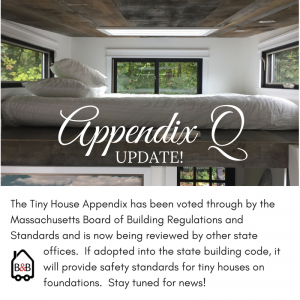 The Tiny House Appendix has been voted through by the Massachusetts Board of Building Regulations and Standards! It is now being reviewed by other state offices. If adopted into the state building code, IRC 2018, it will provide safety standards for building tiny houses on foundations in Massachusetts.
The Tiny House Appendix has been voted through by the Massachusetts Board of Building Regulations and Standards! It is now being reviewed by other state offices. If adopted into the state building code, IRC 2018, it will provide safety standards for building tiny houses on foundations in Massachusetts.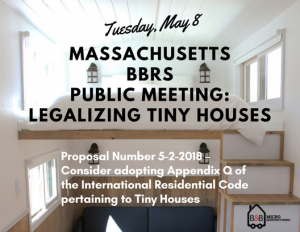 Meeting Addressing Tiny Houses in Massachusetts’ Building Code
Meeting Addressing Tiny Houses in Massachusetts’ Building Code